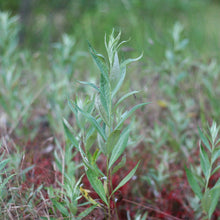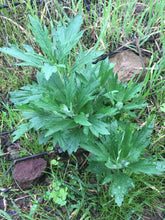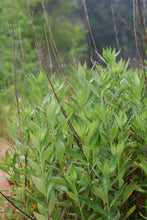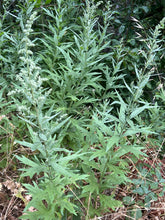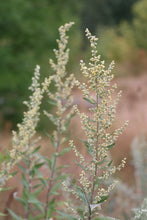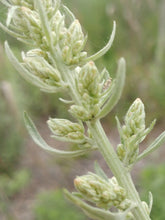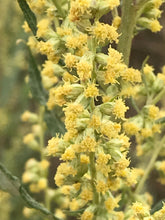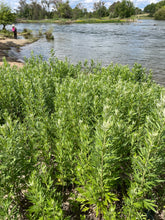
Artemisia douglasiana
We’re excited to debut this esteemed medicinal wonder, with its pleasant aroma, persistent, pollinator-friendly blooms and all-around resilience. Douglas’ sagewort, also known as mugwort or dream plant, is a perennial native plant that grows in a spreading, sub-shrub form and has been used to ignite vivid dreams and ward off bad vibes for thousands of years. A choice foliage plant, its leaves create jagged cleft patterns that are green on the upper surface and silvery-white underneath. The flowers are small and inconspicuous but highly attractive to pollinators. It has been known to spread merrily when planted in ideal conditions, making it very useful in habitat restoration and erosion control.
- Plant type/canopy layer: deciduous, perennial, herbaceous plant
- Size at maturity: 8’ tall; 4’ wide
- Light requirements: full sun to full shade
- Moisture requirements: dry, moist or wet soil; any drainage type
- Bloom time: June - Oct
- Growth rate/ease: fast growing, very easy to grow
- Wildlife support: flowers attract and provide nectar to adult bees and butterflies; seeds are enjoyed by backyard birds; overall plant is a caterpillar host and larval food source for up to 30 species of native butterflies and moths including the American Lady, Painted Lady and the stunning Ruddy Copper (only found in eastern Oregon)
- Native habitat/range: grows in a wide range of habitats from woodlands, , shrublands, and grasslands to riverbanks, drainages, floodplains and disturbed areas, across the western United States and into Baja California. Portland Plant List - yes.
- Special features & uses: deer resistant; landscape uses include pollination gardens, bank stabilization and erosion control; highly medicinal, this plant has been used by indigenous cultures for relief of joint pain and headaches, calming of spasms and other nervous maladies, improvement of digestion and relief from stomach ache, prevention of reflux, processing of rancid fats, as well as an antidote to poison oak skin reactions (which is convenient since the plants often grow together); ceremonially it is used as a dream potentiator and to protect against bad spirits (always seek advice from a professional before using a plant medicinally. Sparrowhawk can not take any responsibility for any adverse effects from the use of plants)
Gardening with Douglas’ Sagewort: Prefers sun and moist soils - but can tolerate pretty much anything you throw at it. Try it with other sunny moisture loving plants like native swamp rose, red twig dogwood, sedges (Carex ssp) and lupines (Lupinus ssp). Alternatively, it can be more manageable as a reliable, tall groundcover in tough dry-shade areas. It rarely produces viable seed but is known to wander, by rhizomes, about the garden at will, especially in damp areas. Some folks love this about it, while others choose to use a soil barrier, contain it in a raised bed or other garden planter, or realize that it’s virtually effortless to pull any unwanted shoots when the soil is moist. Depending on your style, you also may decide to cut it back to ground during dormancy, though this would significantly diminish its habitat value.
Photo Credits 1, 3, 6 (populations in early spring + summer flowers): Karli Del Biondo, Beetles and Bees
Photo Credit 2 (foliage close): © als93, some rights reserved (CC-BY)
Photo Credit 4 (plant with buds): © Bruce Homer-Smith, some rights reserved (CC-BY)
Photo Credit 5 (buds close): © Casey H. Richart, some rights reserved (CC-BY)
Photo Credit 7 (flowers close): © rappman, some rights reserved (CC-BY)
Photo Credit 8 (lakeside population): © Amelia Tauber, some rights reserved (CC-BY)








